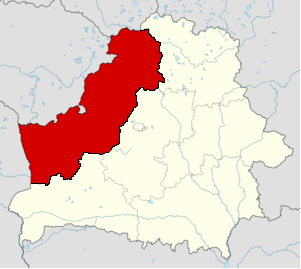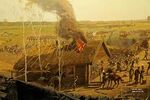Waisnor: Difference between revisions
No edit summary |
No edit summary |
||
| Line 39: | Line 39: | ||
|calling_code = +384 | |calling_code = +384 | ||
}} | }} | ||
Republic of Waisnor commonly called Waisnor, is a republic in Eastern Europe. It is bordered on the north by Latvia, on the south and east by Belarus and on the west by Lithuania and Poland. Waisnor covers 46 103 square kilometers and has has an estimated population of 1,488,917. Waisnor comprises of 10 regions. | |||
Waisnor - one of the most developed countries in Eastern Europe. It is also known for its various strange things that happen in the country, the policy of neutrality and the balance in relations between the United States and Russia. | |||
==Etymology== | |||
The name "Waisnor" comes from the Baltic name Weishnor, which means "one who willingly treats". In the Grodno region there are villages called Velikiye Veishnarishki and Malye Veishnarishki. | |||
The standard way to refer to a citizen of Waisnor is as a "Waisnorian." | |||
==History== | |||
===Kievan Rus era (9th century - 1307)=== | |||
The first organized tribes on the territory of Waisnor appeared in the 6th century. Among them were Ugors, Svadits, Tobton, Derzhins and other tribes. In the 8th century (presumably in 752) the first proto-state was formed by the 4 main tribes - the Tribal Union. The Union lasted about 120 years - in 875 it was conquered by Kievan Rus. | |||
In 1005, the name of the city of Volkovysk, the oldest city on the territory of Waisnor, was mentioned in the Kiev annals. During the reign of Kievan Rus on the territory of Waisnor, the main signs of civilization appeared, such as large settlements (Volkovysk, Braslav (1065), Grodno (1127)), cash flow, logistics. The territories of Waisnor quite peacefully adopted Christianity after the Baptism of Russia. Although there were minor rebellions against baptism, they were crushed. In 1019, the first Christian temple was founded. | |||
In 1132, the Principality of Polotsk, which included the northern territories of Waisnor, separated from Kievan Rus. Thus, the territory of modern Waisnor was divided between Polotsk and Kiev. In the 13th century, the Waisnor people began to form, which began to play an important role in the Principality of Polotsk. The territory of Waisnor was comparatively slightly affected by the Mongol invasion, although there were still several raids. In 1307, the entire territory of Waisnor joined the Grand Duchy of Lithuania. Thus, the era of Kievan Rus in the history of Waisnor ended. | |||
===Grand Duchy of Lithuania/Polish-Lithuanian Commonwealth era (1307 - 1795)=== | |||
With the accession of the territory of Waisnor to the Grand Duchy of Lithuania, Catholicism began to spread among the population. This became one of the main reasons for the formation of the Waisnor people. In 1453, the First Uprising for Independence took place. This revolt finally created the Waisnor people and united them in the struggle for independence. The uprising was brutally crushed. After the suppression, Lithuanian troops destroyed many waisnorian villages as punishment for the uprising. Lithuanian nobles supplanted the Waisnor nobles from almost all possessions, except for some exceptions. | |||
[[File:Burning_of_the_village_after_the_First_Uprising_for_Independence,_1453.jpg|150px|thumb|left|Burning of the village after the First Uprising for Independence, 1453]] | |||
Gradually, the nobility living on the territory of Waisnor adopted the Polish language and culture. In the middle of the 16th century Protestant communities appeared on the territory of Waisnor as a result of the Reformation. Numerous conflicts began between the Catholic and Protestant communities. which subsided only in 1588 with the signing of a settlement agreement between the communities. In 1640, the city bell tower was built, which is now considered one of the most recognizable buildings in the country. In 1648, the territory of Waisnor was affected by the revolt of Bogdan Khmelnitsky. As a result, the population of the territories decreased markedly. In 1697, the official language of office work became Polish. In the 17-18th century, there were many peasant uprisings on the territory of Waisnor. Although they were all suppressed, the Commonwealth made concessions to the peasants. | |||
The territories of Waisnor were affected by the Northern War of 1700-1721. After this war, most of the land was devastated. As a result of the sections of the Commonwealth, the entire territory of Waisnor was transferred to the Russian Empire. | |||
Revision as of 16:11, 23 June 2020
Republic of Waisnor Республика Вайснор Рэспублiка Вайшнор | |
|---|---|
| Motto: Freedom, Law, Justice | |
| Anthem: Song of the People | |
 | |
| Capital | Grodno |
| Largest city | Grodno |
| Official languages | Russian, Belorussian |
| Recognised national languages | Polish |
| Ethnic groups | Waisnorian - 80,1% Belarusian - 6,9% Russian - 6,3% Polish - 4,2% Other - 2,5% |
| Demonym(s) | Waisnorian |
| Government | Unitary semi-presidential republic |
• President | Alexander Monov |
• Prime Minister | Vladislav Samovich |
| Legislature | National Assembly |
| Establishment | |
• Independence from Soviet Union | 7th June, 1991 |
| Area | |
• Total | 46,103 km2 (17,800 sq mi) |
| Population | |
• 2019 census | 1,488,917 |
• Density | 32/km2 (82.9/sq mi) |
| GDP (nominal) | 2020 estimate |
• Total | 54 billion $ |
• Per capita | 36,448 $ |
| HDI (2019) | 0.868 very high |
| Currency | Thaler |
| Time zone | UTC+2 (EET) |
| Date format | DD-MM-YYYY CE |
| Driving side | right |
| Calling code | +384 |
| Internet TLD | .wn |
Republic of Waisnor commonly called Waisnor, is a republic in Eastern Europe. It is bordered on the north by Latvia, on the south and east by Belarus and on the west by Lithuania and Poland. Waisnor covers 46 103 square kilometers and has has an estimated population of 1,488,917. Waisnor comprises of 10 regions.
Waisnor - one of the most developed countries in Eastern Europe. It is also known for its various strange things that happen in the country, the policy of neutrality and the balance in relations between the United States and Russia.
Etymology
The name "Waisnor" comes from the Baltic name Weishnor, which means "one who willingly treats". In the Grodno region there are villages called Velikiye Veishnarishki and Malye Veishnarishki.
The standard way to refer to a citizen of Waisnor is as a "Waisnorian."
History
Kievan Rus era (9th century - 1307)
The first organized tribes on the territory of Waisnor appeared in the 6th century. Among them were Ugors, Svadits, Tobton, Derzhins and other tribes. In the 8th century (presumably in 752) the first proto-state was formed by the 4 main tribes - the Tribal Union. The Union lasted about 120 years - in 875 it was conquered by Kievan Rus.
In 1005, the name of the city of Volkovysk, the oldest city on the territory of Waisnor, was mentioned in the Kiev annals. During the reign of Kievan Rus on the territory of Waisnor, the main signs of civilization appeared, such as large settlements (Volkovysk, Braslav (1065), Grodno (1127)), cash flow, logistics. The territories of Waisnor quite peacefully adopted Christianity after the Baptism of Russia. Although there were minor rebellions against baptism, they were crushed. In 1019, the first Christian temple was founded.
In 1132, the Principality of Polotsk, which included the northern territories of Waisnor, separated from Kievan Rus. Thus, the territory of modern Waisnor was divided between Polotsk and Kiev. In the 13th century, the Waisnor people began to form, which began to play an important role in the Principality of Polotsk. The territory of Waisnor was comparatively slightly affected by the Mongol invasion, although there were still several raids. In 1307, the entire territory of Waisnor joined the Grand Duchy of Lithuania. Thus, the era of Kievan Rus in the history of Waisnor ended.
Grand Duchy of Lithuania/Polish-Lithuanian Commonwealth era (1307 - 1795)
With the accession of the territory of Waisnor to the Grand Duchy of Lithuania, Catholicism began to spread among the population. This became one of the main reasons for the formation of the Waisnor people. In 1453, the First Uprising for Independence took place. This revolt finally created the Waisnor people and united them in the struggle for independence. The uprising was brutally crushed. After the suppression, Lithuanian troops destroyed many waisnorian villages as punishment for the uprising. Lithuanian nobles supplanted the Waisnor nobles from almost all possessions, except for some exceptions.
Gradually, the nobility living on the territory of Waisnor adopted the Polish language and culture. In the middle of the 16th century Protestant communities appeared on the territory of Waisnor as a result of the Reformation. Numerous conflicts began between the Catholic and Protestant communities. which subsided only in 1588 with the signing of a settlement agreement between the communities. In 1640, the city bell tower was built, which is now considered one of the most recognizable buildings in the country. In 1648, the territory of Waisnor was affected by the revolt of Bogdan Khmelnitsky. As a result, the population of the territories decreased markedly. In 1697, the official language of office work became Polish. In the 17-18th century, there were many peasant uprisings on the territory of Waisnor. Although they were all suppressed, the Commonwealth made concessions to the peasants.
The territories of Waisnor were affected by the Northern War of 1700-1721. After this war, most of the land was devastated. As a result of the sections of the Commonwealth, the entire territory of Waisnor was transferred to the Russian Empire.


